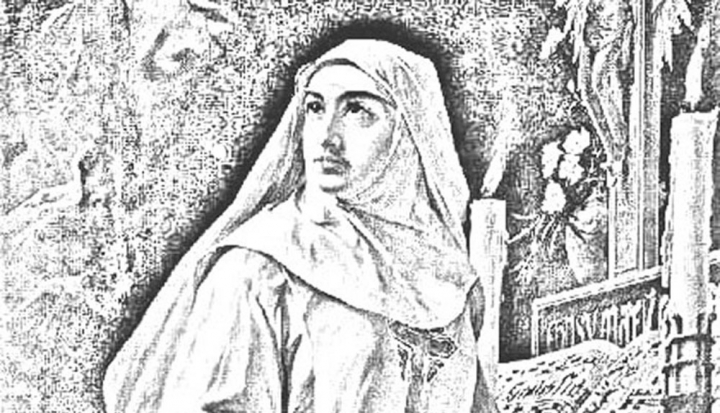“We fluctuate long between love and hatred before we can arrive at tranquillity.”
—Heloise
The year was 2016, and I was beginning my senior year of university at Loyola University Chicago. Being a Jesuit school, the university required two semesters of theology courses, and I had saved my second for my last semester. With few options left, I chose to take a Wednesday night class called “Women in Religion.”
I’ll admit my attendance in this course was reluctant at best, but I showed up week after week and participated enough to pass the class. We learned about many women, mostly martyrs, but none made much of an impact beyond “remember this for the test. Remember this for the test.” That is, until we learned about Heloise.
Heloise’s story was so different from the pious martyrs we had learned about. I honestly could not relate to Perpetua, who willingly gave her life as one of the first martyrs of the church. Catherine of Siena provided little material to relate to, either, as I have never deprived myself of food in order to solidify my piety. I was a regular college girl on the cusp of graduating, worried about the future and hopelessly in love with a man who would never love me back.
Enter Heloise, a medieval French nun who was wise and intelligent beyond her years. She may seem like an odd role model for a Millennial, but I found myself connecting with her quite a bit.
Heloise was born sometime in 1101—the official date is unknown, as is the identity of her father—in the Convent of Saint Mary in Argenteuil, France. She was raised in an enriched learning environment, quickly showing signs of advanced intelligence. Her mother recognized her capabilities and knew she was going to have to send her beyond their cloistered home.
So she sent Heloise to Paris to study theology, philosophy, and literature. During her time there, while living under the protective care of her uncle, her intelligence and beauty caught the eye of theologian and all-around academic superstar Peter Abelard.
Quick background on Peter Abelard: He was a notable medieval theologian and philosopher in Paris who worked as a teacher and tutor. He apparently caught wind of a young, beautiful, and strikingly intelligent woman who had just moved to Paris and quickly got in contact with Heloise’s uncle, Abbot Fulbert, to offer his tutoring services.
And thus a romance was born.
At this point my collegiate mind, hopelessly involved in an unrequited love, perked up. My professor finally had my undivided attention. A love story? Count me in.
Peter Abelard began tutoring Heloise. He was fascinated by her mind, and she was equally as taken with his. What began as innocent tutoring resulted in a torrid love affair—one that had to be hidden. Abelard writes of their tutoring sessions in a letter to a friend:
“Her studies allowed us to withdraw in private, as love desired, and then with our books open before us, more words of love than of reading passed between us, and more kissing than teaching.” (Gollancz, Historica Clamitatum: A Letter to his Friend Philintus)
Eventually, Heloise and Abelard’s affair resulted in Heloise’s pregnancy. Abelard convinced Heloise to marry him, against her wishes. Heloise knew a domestic marriage would hold them both back from accomplishing their goals; she pushed back against Abelard’s proposal. Some historians suggest Heloise was against marriage entirely, seeing it as a transaction in which a woman is merely property to be sold. But Heloise eventually gave in and agreed to marry Abelard. They left their son in the care of Abelard’s family and returned to Paris.
Despite their marriage, the two continued to keep their relationship secret after they returned. Heloise still lived within the confines of her uncle’s home, and Abelard visited her under the guise of continuing her tutoring. The truth always comes out, though, and it wasn’t long before Fulbert learned of the marriage. Furious, he took out his anger on Heloise—even to the point of beating her.
Abelard urged Heloise to return to the convent she was raised in for her own safety. But this outraged Fulbert once again, this time by the mistaken notion that Abelard had abandoned his niece. And so Fulbert did what any sensible medieval man would do and proceeded to castrate his nephew-in-law.
This event was, understandably, traumatic for Abelard. Ashamed of his injury, he retreated from the public eye and entered a monastery. Abelard urged Heloise to join him in cloistered life so that they could live parallel albeit separate lives. Again, Heloise initially was not thrilled with Abelard’s suggestion and was reluctant to follow him into religious life. But apparently true love knows no bounds, and Heloise took her vows and became a nun.
Abelard and Heloise continued exchanging love letters—many of which were quite explicit—during their time apart. At times Heloise would ask that they be reunited, but Abelard would always decline, stating his new status rendered their marriage null. So they continued to encourage each other from afar, supporting each other’s studies and respective academic works.
Heloise eventually became the abbess of her convent, and her letters to Abelard address her issues with monastic life. Over time, the letters shift in tone: No longer do they highlight their personal joys and heartbreak but instead the reforms needed within their respective communities.
Though initially drawn to Heloise because of her tumultuous and forbidden love affair, what keeps drawing me back to her is her independence and desire to create change in her community that developed during this time of her life. She was far ahead of her time in her views on marriage and education. In fact, part of her legacy remains in the intensely studious nature of the nuns who were under her guidance and all of the women who came after, including this 21st-century college student.
Heloise noticed that the Benedictine Rule, under which both Benedictine monasteries and convents operated, was not suitable for women, who had different physical needs. So, with the help of Abelard, who as a man had more political power, she rewrote the Benedictine Rule.
Her new version of monastic life chanced details such as what the women in the convent wore, their diet, and how women were punished who misbehaved. (These punishments were often quite violent: Women who left the convent without permission were kept in isolation and fed only bread and water. Women who did not uphold the vow of chastity were beaten and no longer permitted to wear the habit.)
Mary Martin Mclaughlin describes Heloise as a “questioner and maker of just requests,” lauding her role in expanding women’s religious life. Her reforms placed the spiritual lives of women as equal to those of men religious. It was because of her insistence on the equality of women and men’s spiritual leadership in the church that she was highly respected by both her fellow nuns and monks in the surrounding monasteries. Her legacy lived on; her reformed version of the Rule was made standard for all convents until the French Revolution.
In 1904, Henry Adams referred to Heloise as a “Frenchwoman to the last millimeter of her shadow” and “by French standards worth at least a dozen Abelards.” He also stated that the “twelfth century, with all its sparkle, would be dull without Abelard and Heloise.”
Though certainly not a 12th-century scholar, I wholeheartedly agree with Adams’ assessment of Heloise. Her story inspired me to become more interested and devoted to the topic of women in the religious sphere. Her brilliant mind, capacity to lead, and passion for both love and knowledge makes her one of my favorite—albeit unlikely—role models.













Add comment